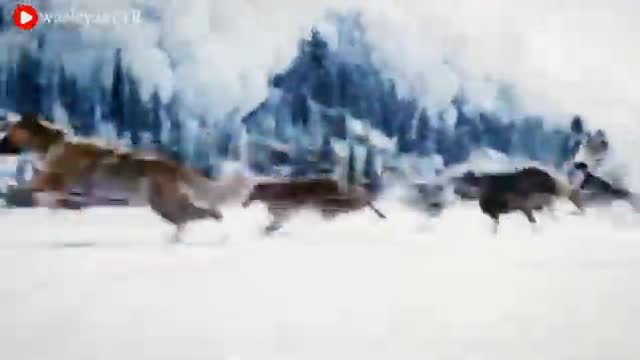Premium Only Content

Brave Dogs'🐕 Helping video🔥 //Dog lovers🐕//
The domestic dog (Canis familiaris or Canis lupus familiaris)[4] is a domesticated descendant of the wolf. The dog derived from an ancient, extinct wolf,[5][6] with the modern grey wolf being the dog's nearest living relative.[7] The dog was the first species to be domesticated,[8][7] by hunter-gatherers over 15,000 years ago,[6] before the development of agriculture.[1] Their long association with humans has led dogs to be uniquely adapted to human behavior,[9] leading to a large number of domestic individuals[10] and the ability to thrive on a starch-rich diet that would be inadequate for other canids.[11]
Domestic dogs
Temporal range: At least 14,200 years ago – present[1]









Conservation status
Domesticated
Scientific classificationKingdom:AnimaliaPhylum:ChordataClass:MammaliaOrder:CarnivoraFamily:CanidaeSubfamily:CaninaeTribe:CaniniSubtribe:CaninaGenus:CanisSpecies:
C. lupus
Subspecies:
C. l. familiaris
Trinomial nameCanis lupus familiaris
Linnaeus, 1758[2]
Synonyms
[3]
C. aegyptius Linnaeus, 1758
C. alco C. E. H. Smith, 1839,
C. americanus Gmelin, 1792
C. anglicus Gmelin, 1792
C. antarcticus Gmelin, 1792
C. aprinus Gmelin, 1792
C. aquaticus Linnaeus, 1758
C. aquatilis Gmelin, 1792
C. avicularis Gmelin, 1792
C. borealis C. E. H. Smith, 1839
C. brevipilis Gmelin, 1792
C. cursorius Gmelin, 1792
C. domesticus Linnaeus, 1758
C. extrarius Gmelin, 1792
C. ferus C. E. H. Smith, 1839
C. fricator Gmelin, 1792
C. fricatrix Linnaeus, 1758
C. fuillus Gmelin, 1792
C. gallicus Gmelin, 1792
C. glaucus C. E. H. Smith, 1839
C. graius Linnaeus, 1758
C. grajus Gmelin, 1792
C. hagenbecki Krumbiegel, 1950
C. haitensis C. E. H. Smith, 1839
C. hibernicus Gmelin, 1792
C. hirsutus Gmelin, 1792
C. hybridus Gmelin, 1792
C. islandicus Gmelin, 1792
C. italicus Gmelin, 1792
C. laniarius Gmelin, 1792
C. leoninus Gmelin, 1792
C. leporarius C. E. H. Smith, 1839
C. major Gmelin, 1792
C. mastinus Linnaeus, 1758
C. melitacus Gmelin, 1792
C. melitaeus Linnaeus, 1758
C. minor Gmelin, 1792
C. molossus Gmelin, 1792
C. mustelinus Linnaeus, 1758
C. obesus Gmelin, 1792
C. orientalis Gmelin, 1792
C. pacificus C. E. H. Smith, 1839
C. plancus Gmelin, 1792
C. pomeranus Gmelin, 1792
C. sagaces C. E. H. Smith, 1839
C. sanguinarius C. E. H. Smith, 1839
C. sagax Linnaeus, 1758
C. scoticus Gmelin, 1792
C. sibiricus Gmelin, 1792
C. suillus C. E. H. Smith, 1839
C. terraenovae C. E. H. Smith, 1839
C. terrarius C. E. H. Smith, 1839
C. turcicus Gmelin, 1792
C. urcani C. E. H. Smith, 1839
C. variegatus Gmelin, 1792
C. venaticus Gmelin, 1792
C. vertegus Gmelin, 1792
The dog has been selectively bred over millennia for various behaviors, sensory capabilities, and physical attributes.[12] Dogs are sub classified into breeds, which vary widely in shape, size, and color.[13] They perform many roles for humans, such as hunting, herding, pulling loads, protection, assisting police and the military, companionship, therapy, and aiding disabled people. This influence on human society has given them the sobriquet of "man's best friend."
-
 0:58
0:58
akosnemeth
4 years agodog helping funny video
34 -
 32:15
32:15
DeVory Darkins
7 hours ago $3.35 earnedDemocrats PAINFULLY WRECKED by Tom Homan as paid protesters ERUPT in Chicago
3.11K24 -
 16:59
16:59
Degenerate Jay
12 hours ago $0.92 earnedIs Metal Gear Solid Delta: Snake Eater Worth Buying?
18.2K2 -
 LIVE
LIVE
Flex011
4 hours ago $0.05 earnedCronos: The New Dawn – Brutal Time-Travel Horror Survival
47 watching -
 33:11
33:11
The Finance Hub
16 hours ago $0.72 earnedBREAKING: JD VANCE JUST RELEASED A MASSIVE BOMBSHELL!!! OMG!!
1.74K16 -
 18:06
18:06
Professor Gerdes Explains 🇺🇦
14 hours agoAfter Major Attack, Trump Vows "Phase II" Sanctions on Russia
3.78K7 -
 LIVE
LIVE
EVASIVE_rabbi
4 hours ago✅️ 2 Dumb Navy Vets & A First Playthrough #Coop ✅️
56 watching -
 LIVE
LIVE
Cook14u
8 hours agoSeahawks Let Me Down, DO NOT Talk About How I Look 🤐🙃🥴
16 watching -
 8:18
8:18
MattMorseTV
15 hours ago $9.28 earned2.2 MILLION in ONE YEAR.
64.4K145 -
 LIVE
LIVE
TheKappaConvict
2 hours agoRainbow Six Siege X Lets send Em Packing Boys | The kappa Convict
11 watching